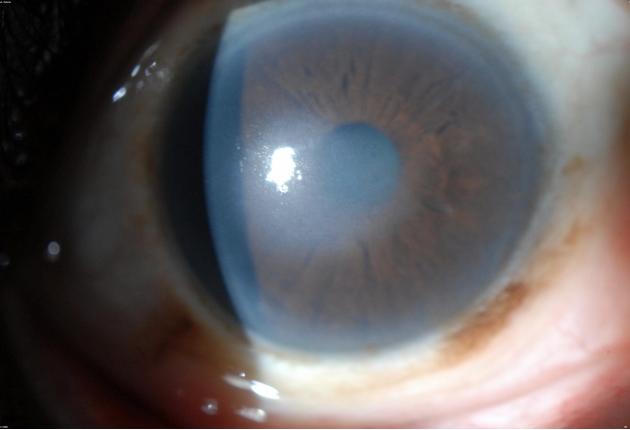 Fuchs' dystrophy is a condition that causes the cornea to degenerate, particularly in the innermost layers or the endothelium of the cornea. This area is responsible for maintaining proper fluid amounts in the cornea and keeping the cornea clear to promote good vision. This disease is often genetic but in many cases the ultimate cause of Fuchs' dystrophy is unknown. It often appears in both eyes simultaneously, causing corneal swelling, clouding and the vision to gradually decline. There is no preventative therapy available for Fuchs' dystrophy.
Fuchs' dystrophy is a condition that causes the cornea to degenerate, particularly in the innermost layers or the endothelium of the cornea. This area is responsible for maintaining proper fluid amounts in the cornea and keeping the cornea clear to promote good vision. This disease is often genetic but in many cases the ultimate cause of Fuchs' dystrophy is unknown. It often appears in both eyes simultaneously, causing corneal swelling, clouding and the vision to gradually decline. There is no preventative therapy available for Fuchs' dystrophy.
Symptoms of Fuchs' Dystrophy
Common symptoms of Fuchs' dystrophy include eye pain, sensitivity to light, glare, blurred or foggy vision, difficulty seeing at night, seeing halos around lights and a general feeling that something is in the eye. You may also notice that you have poor vision in the morning which gets progressively better throughout the day.
Risk Factors of Fuchs' Dystrophy
- Age. You are more likely to develop Fuchs' dystrophy after the age of 50. It is possible to detect signs that the disease is present in younger patients, but severe symptoms will not appear until the patient reaches a more advanced age.
- Gender. Women are more likely to develop Fuchs' dystrophy than men. Those that have parents which suffered from Fuchs' dystrophy are approximately 50 percent more likely to develop the disease themselves.
Detection of Fuchs' Dystrophy
An ophthalmologist or optometrist can perform a comprehensive eye exam to check for signs of Fuchs' dystrophy. A slit lamp will be used to magnify and examine the cornea in a high degree of detail. This will allow your doctor to check for changes in the endothelium cells that signal the disease might be present. In early stages of the disease, the cells in the corneal endothelium and drop-like lesions called the corneal guttata will begin to decrease.
Your doctor may also check the corneal thickness or pachymetry as an increase of this thickness can be a sign that your cornea has begun to swell due to the presence of Fuchs' dystrophy. In some cases, your doctor will use an eye chart to measure your visual acuity to determine if swelling of the corneas is affecting the quality of your vision.
Treatments for Fuchs' Dystrophy
Those that have been diagnosed with Fuchs' dystrophy should let their doctor know, particularly if you are considering eye surgery such as LASIK or cataract surgery. Eye surgery can make this condition worse and Fuchs' dystrophy is typically considered a contraindication for any elective refractive surgery.
The type of treatment you will require for Fuchs' dystrophy will vary based on the stage the disease is in once it is detected. Early cases can often be treated by administering 5 percent sodium chloride drops that will remove excess water from the cornea area.
As the condition worsens, the risk of the epithelial bullae rupturing increases. This may lead to poor vision and painful corneal abrasions. At this point your Fuchs' dystrophy will need to be treated with a cornea transplant to correct serious vision loss.
Those that have developed ocular hypertension or endothelial dystrophy may be prescribed glaucoma eye drops to help manage the intraocular pressure. Otherwise this pressure can cause damage to the corneal endothelium which will make your symptoms worse.
An alternative to a full-thickness corneal transplant to address Fuchs' dystrophy is a deep lamellar endothelial keratoplasty that replaces the endothelium but leaves the upper layers of the cornea intact. In recent years, this surgery has been used more often because it poses fewer risks than a standard full-thickness corneal transplant. A laser stripping method known as femtosecond laser-assisted Descement stripping endothelial keratoplasty has helped to make this process go more smoothly.
